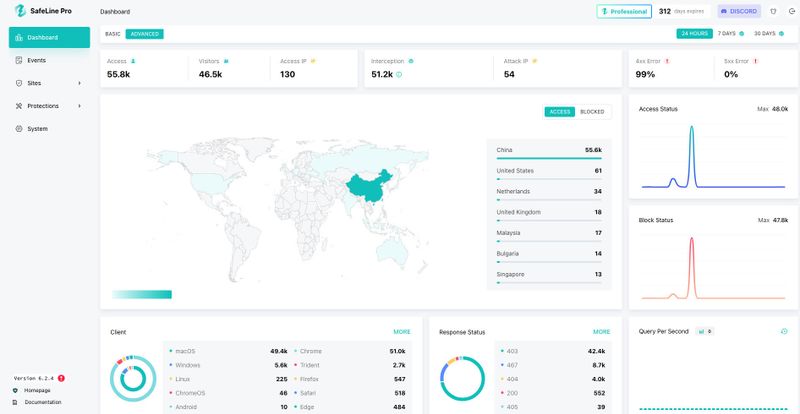Web Application Firewalls (WAFs) are critical for protecting modern web applications from evolving threats. FortiWeb is widely recognized in enterprise environments, while SafeLine is gaining attention for its high-performance traffic inspection and flexible deployment.
So how do they stack up? Let’s dive into a practical comparison.
Overview
| Feature | SafeLine | FortiWeb |
|---|---|---|
| License | Free to use, no license required | Commercial, subscription-based |
| Deployment | Docker, Bare Metal, K8s | Appliance, Virtual Machine, Cloud |
| Detection Engine | Intelligent semantic analysis engine | Signature, behavior, ML-based |
| Bot Protection | ✅ Yes | ✅ Yes |
| API Security | ✅ Yes | ✅ Yes |
| Zero-Day Defense | ✅ Real-time inspection | ✅ With ML and threat intel |
| DevOps Friendly | ✅ CI/CD ready | ❌ Mostly GUI-driven |
| Learning Curve | Low | Medium to High |
Detection Capabilities
FortiWeb combines traditional signatures with anomaly detection and threat intelligence. It’s a robust solution but may require fine-tuning for accuracy, especially in dynamic app environments.
SafeLine, in contrast, focuses on real-time semantic analysis. Instead of matching predefined rules, it evaluates the intent and context of each request. This enables it to detect advanced and evasive threats, such as:
- Obfuscated XSS or SQL payloads
- Custom command injection attempts
- Zero-day exploits with no known signatures
Deployment Flexibility
SafeLine is designed for modern architectures:
- Runs on Docker, bare metal, or Kubernetes
- Supports reverse proxy and transparent modes
- Can be used as a sidecar or ingress controller in microservices
FortiWeb is better suited for traditional enterprise setups, often deployed as a standalone appliance or cloud VM. It offers rich GUI-based management but lacks native DevOps integration.
Cost and Maintainability
FortiWeb is a commercial-grade product with professional support, centralized logging, and advanced modules — but comes at a cost.
SafeLine is available without a license and can be deployed instantly. It provides full traffic inspection, bot mitigation, and rate-limiting features without ongoing fees. Ideal for teams that prefer self-managed security without vendor lock-in.
Ideal Use Cases
| Use Case | SafeLine | FortiWeb |
|---|---|---|
| Self-hosted environments | ✅ Yes | ❌ Not ideal |
| DevOps automation | ✅ Yes | ⚠️ Limited |
| High-traffic enterprise apps | ✅ Yes | ✅ Yes |
| Security teams with tight budgets | ✅ Yes | ❌ No |
| All-in-one security platform | ❌ WAF only | ✅ WAF + more |
Final Thoughts
If you're building in a DevOps-centric environment and want a lightweight, high-performance WAF with intelligent traffic filtering, SafeLine is worth serious consideration.
For enterprises needing an all-in-one security suite with vendor support, extensive GUI tools, and advanced threat feeds, FortiWeb remains a solid choice.
Learn more about SafeLine:
Github:https://github.com/chaitin/SafeLine
Setup Guide: https://docs.waf.chaitin.com/
Discord Community:https://discord.gg/dy3JT7dkmY
Learn more about Fortiweb:
Official Website: https://www.fortinet.com/products/web-application-firewall/fortiweb
Github:https://github.com/kh4sh3i/FortiWeb





Top comments (3)
When choosing between FortiWeb and SafeLine for your web application firewall (WAF) needs, the decision often hinges on your specific priorities—enterprise-grade integration or cutting-edge performance. FortiWeb, backed by Fortinet's trusted ecosystem, offers robust threat intelligence, seamless scalability, and deep analytics, making it a "yes" for large-scale businesses. On the other hand, SafeLine shines with its lightweight architecture, high-speed traffic inspection, and developer-friendly deployment options—another strong "yes" if agility and performance are your focus. So, should you choose FortiWeb or SafeLine? It depends on your environment—but asking the right “choose yes or no” questions about security, scalability, and flexibility can guide you to the best fit.
Choosing between FortiWeb and SafeLine depends on your web app’s security needs FortiWeb offers AI-driven WAF protection, while SafeLine focuses on traffic integrity. For simple, secure browsing experiences like when exploring the El Pollo Loco menu a strong WAF ensures your app stays safe and fast.
FortiWeb is best for full featured web app protection with AI and threat intelligence. SafeLine is simpler and more lightweight. Choose based on your app’s complexity and security needs.